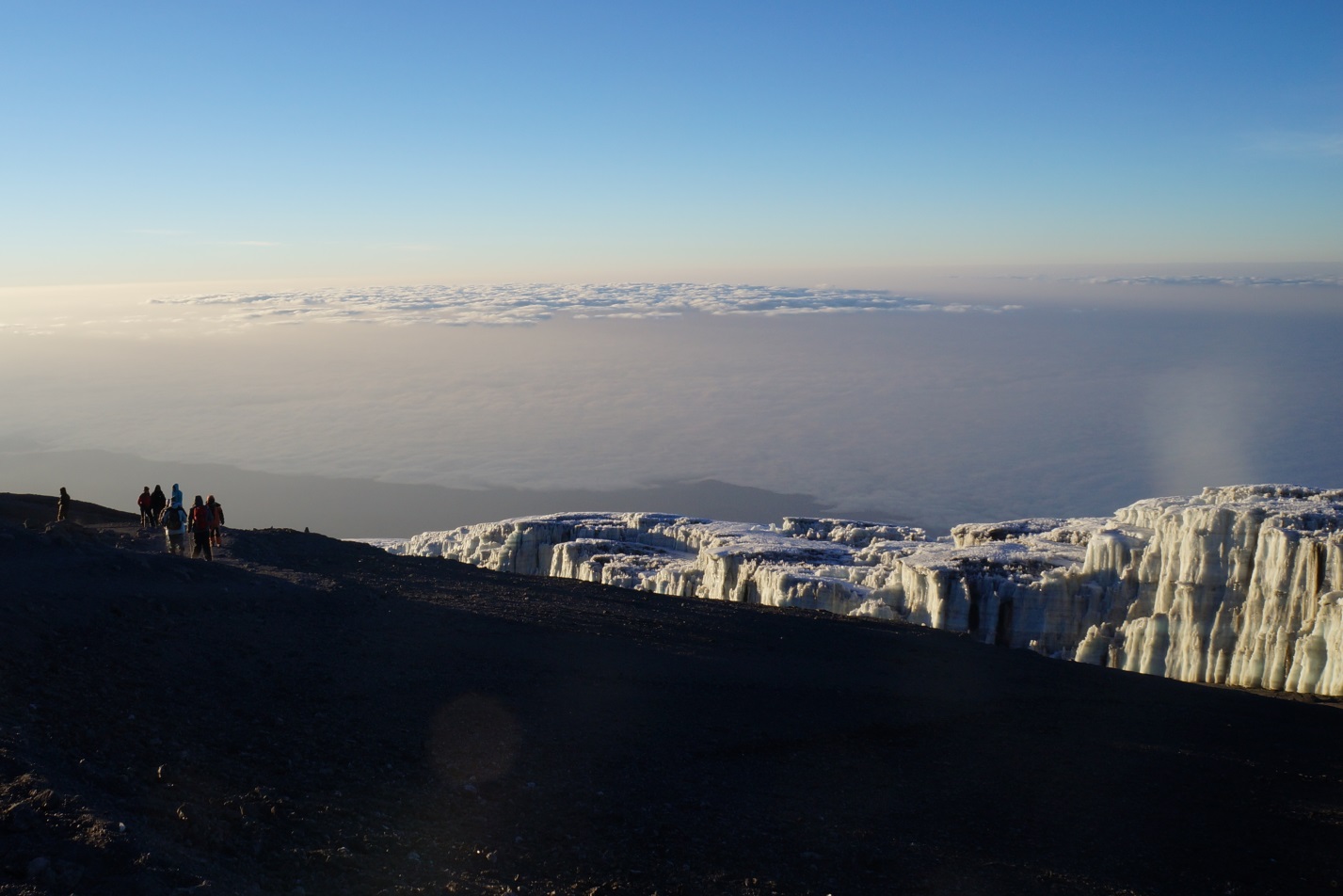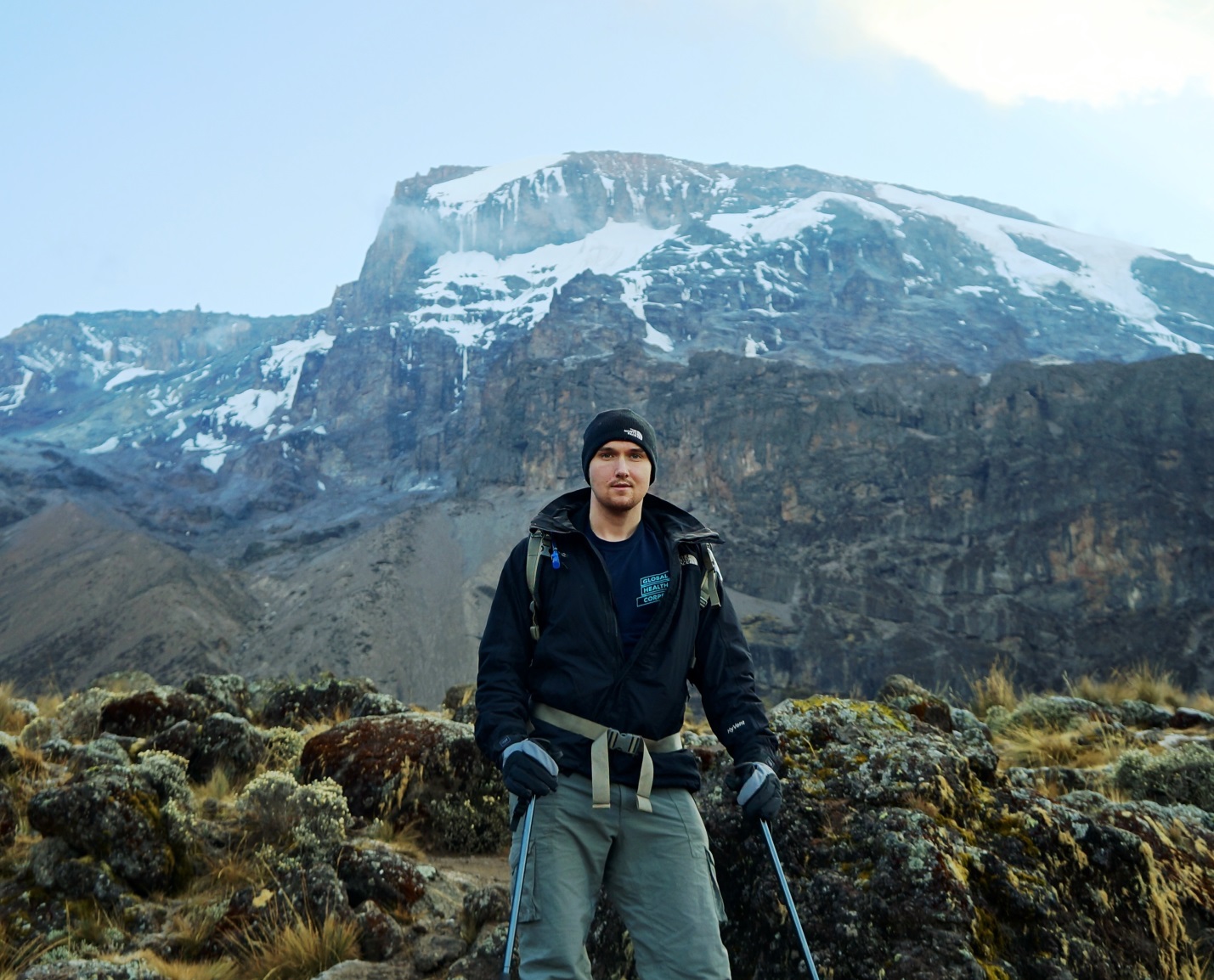
(Sunrise from near Mt. Kilimanjaro’s highest point. Photo Credit: David Budiac, climbing partner)
Uhuru Peak, Mt. Kilimanjaro. September 29th, 2013, 6:15 AM. Altitude: 5,895 meters above mean sea level—Africa’s highest point. Air pressure: 497 hectopascals—a little over half that of the savannas far below. Humidity: 10%—drier than a typical desert. Temperature: -5.5 degrees Celsius—the coldest reading I had recorded since my climbing partners and I began our overnight push to the summit at around midnight. The equatorial sun was rising in the east, elevating temperatures well above freezing before my exhausted team could return to Barafu Camp, Kili’s high base camp named after the Swahili word for ice.
“Ice” is perhaps becoming misnomer. Registering low pressure, low humidity, and temperatures routinely crossing the freezing point even at extreme altitudes, my small collection of amateur measurement devices built on a well-publicized trend; chalk up another set of data points in the “retreating glaciers” column.
Hemmingway’s “snows of Kilimanjaro”—relics of the past enshrined in the pages of the venerable author—appear to be deliquescing from the mountainous African landscape. Teams of climbers ascending the storied peak to stand above the spectacle of equatorial ice may one day see none of the glaciers that have served as the Kili’s trademark for centuries. Perhaps their photos won’t be as impressive. Maybe fewer affluent adventurers will visit. If global climate change (rather than regional factors like deforestation) is primarily to blame, however, there are much bigger problems to consider.

(Passing one of Kilimanjaro’s largest remaining glaciers. Photo Credit: Tim Mahoney, climbing partner)
Forget Hemingway. Forget the polar bears. Forget the Great Barrier Reef.
Forget the most visible signs and symptoms of climate change, that is to say, until you’ve considered the broader issues. Climate change threatens the chemical and physical properties of the biosphere which support life as we know it. We don’t have the luxury of worrying about aesthetics.
To be sure, there is much more than aesthetics at risk for the communities surrounding Mt. Kilimanjaro should the barafu melt and sublime away from its fabled home. Likewise, there is much to be lost should delicate arctic and marine ecosystems continue to be imperiled by unprecedented climatic changes. However, harping on such issues alone is akin to treating a cough while failing to diagnose the underlying pneumonia.

(Ascending near the Barranco wall. Photo Credit: Dean Leichtle, climbing partner)
Climate change poses broader threats to human health than can be easily identified through its most visible symptoms. The threat of widespread malnutrition could rise as crops and fisheries suffer and the global population grows. Meanwhile, warmer temperatures could expand habitats for vectors and pathogens. Compounding these issues, a rising incidence of extreme weather could spur acute public health problems, especially in many of the places least prepared to cope with them. In the worst case scenarios, Thomas Hobbes meets Thomas Friedman: life becomes “nasty, brutish, and short” in a “hot, flat, and crowded” world.
Much remains uncertain in the complex global environmental-economic system, but the risks are clear and abundant. Unfortunately, however, too little attention seems to be invested in finding viable solutions to protect human health while too much is squandered in blame: poorer countries blaming wealthier countries, wealthier blaming poorer countries, all kinds of people blaming the fossil fuel industry (for which many of these people happen to serve as outstanding customers)…

(Camping à la Van Gogh: “starry night” on the mountain. Photo Credit: David Budiac, climbing partner)
Nearly everyone who has lived since the Industrial Revolution has contributed to environmental degradation in one form or another. We are all culpable. Moreover, playing the blame game isn’t likely to solve much.
The prudent response to the changing climate that one can observe in so many places is to evaluate the most relevant risks and think of realistic ways to address them on both a large and small scale.
So, like me, you still care about the mountains, the bears, the reefs, and countless other environmental symbols of the climate? First and foremost, it is only reasonable to consider the threats to our own health and that of the people with whom we share the planet—moving beyond blame and towards solutions. For me, this means working towards health equity as a Global Health Corps fellow. For others, this could mean a vast array of work which moves beyond blame towards responsible solutions to the environmental challenges facing the world and the health of those who inhabit it.
Serving with Global Health Corps offers an opportunity to see Mt. Kilimanjaro and countless other incredible places. More importantly, it offers the platform to consider these wonders from a global health perspective and to work on the front lines of the health equity movement.

(Summit area view from Barranco Camp. Photo Credit: Tim Mahoney, climbing partner)
